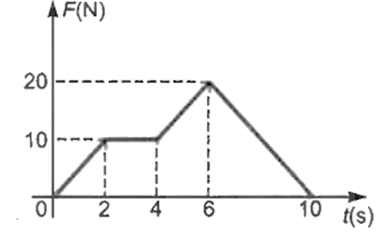 Multiple Choice Questions
Multiple Choice QuestionsA stationary body of mass 3 kg explodes into three equal pieces. Two of the pieces fly off in two mutually perpendicular directions, one with a velocity of ms-1 and the other with a velocity of ms-1. If the explosion occurs in 10-4 s, the average force acting on the third piece in newton is
A mass of 1 kg is just able to slide down the slope of an inclined rough surface when the angle of inclination is 60°. The minimum force necessary to pull the mass up the inclined plane (g = 10 ms-2) is
14.14 N
17.32 N
10 N
16.66 N
B.
17.32 N
The component of weight mg of block along the inclined plane = mg sin θ. The minimum frictional force to be overcome is also mg sin θ. To make the block just move up the plane the minimum force applied must overcome the component mg sin θ of gravitational force as well as the frictional force mg sin θ = 2 mg sin θ.
∴ Force needed = 2 mg sin θ
= 2 × 1 × 10 × sin 60°
= 20 ×
= 17.32 N
A block of mass m is resting on a smooth horizontal surface. One end of a uniform rope of mass is fixed to the block, which is pulled in the horizontal direction by applying force F at the other end. The tension in the middle of the rope is
A bullet of mass 0.05 kg moving with a speed of 80 ms enters a wooden block and is stopped after a distance of 0.40 m. The average resistive force exerted by the block on the below is
300 N
20 N
400 N
40 N
A particle of mass 2 kg is initially at rest. A force acts on it whose magnitude changes with time. The force time graph is shown below.

The velocity of the particle after 10 s is
20 ms-1
10 ms-1
50 ms-1
26 ms-1
The sum of the magnitudes of two forces acting at a point is 18 N and the magnitude of their resultant is 12 N. If the resultant is at 90° with the smaller force, the magnitude of the forces in N are
6, 12
11, 7
5, 13
14, 4
A mass of 6 kg is suspended by a rope of length 2 m from a ceiling. A force of 50 N in the horizontal direction is applied at the mid-point of the rope. The angle made by the rope with the vertical, in equilibrium is
50°
60°
30°
40°
A shell at rest at the origin explodes into three fragments of masses 1 kg, 2 kg and m kg. The 1 kg and 2 kg pieces fly off with speeds of 5 ms-1 along x-axis and 6 ms-2 along y-axis respectively. If the m kg piece flies off with a speed of 6.5 ms-1, the total mass of the shell must be
4 kg
5 kg
3.5 kg
4.5 kg
If the road is unbanked and the coefficient of friction between the road and the tyres is 0.8, then the maximum speed with which an automobile can move around a curve of 84.5 m radius without slipping (g = 10 ms-2) is
26 ms-1
67.6 ms-1
13 ms-1
36.7 ms-1
Three blocks of masses m1 m2 and m3 are connected by massless string as shown kept on a frictionless table.

They are pulled with a force T3 = 40 N. If m1 = 10 kg, m2 = 6 kg and m3 = 4 kg, the tension T2 will be
20 N
40 N
10 N
32 N
